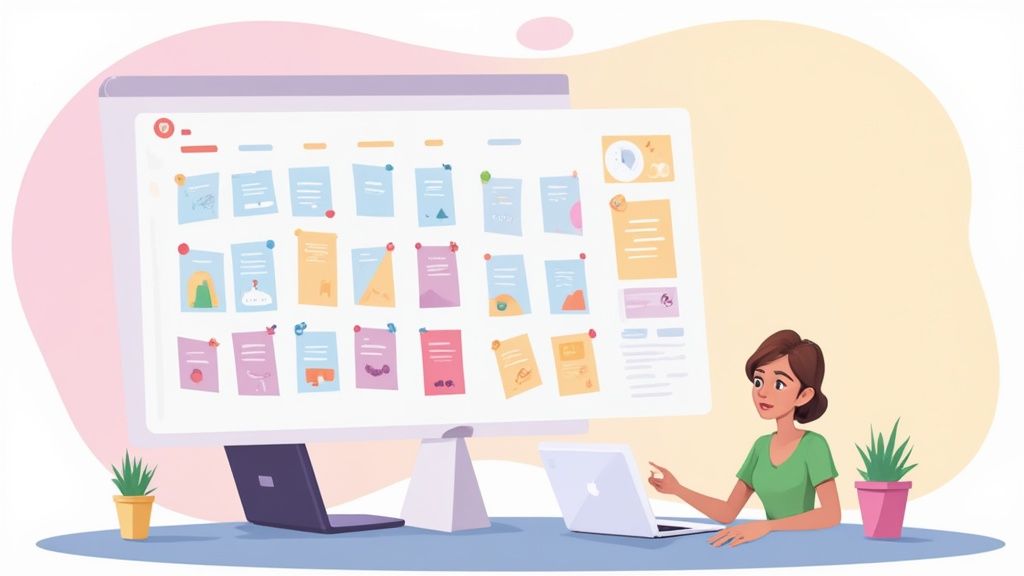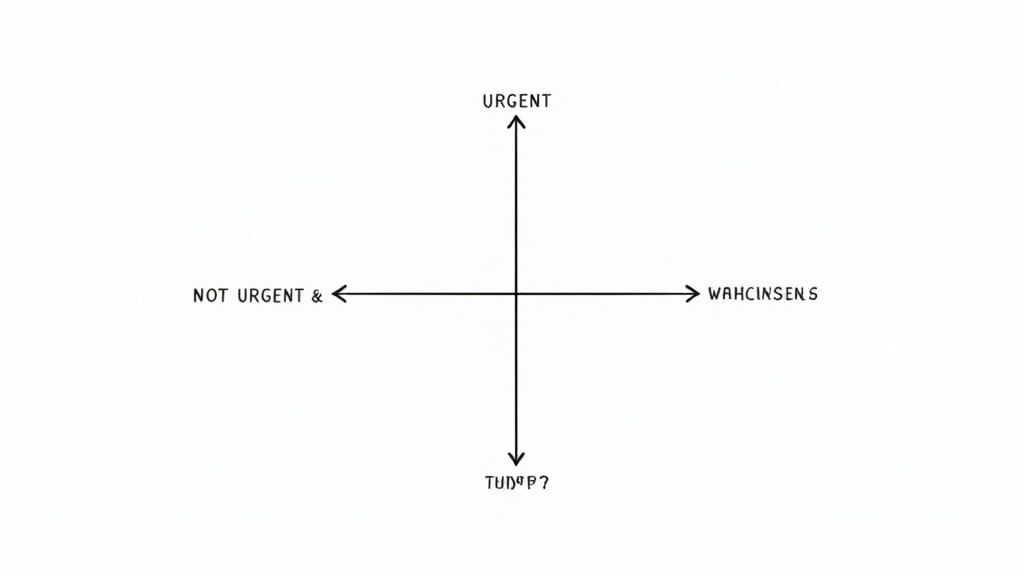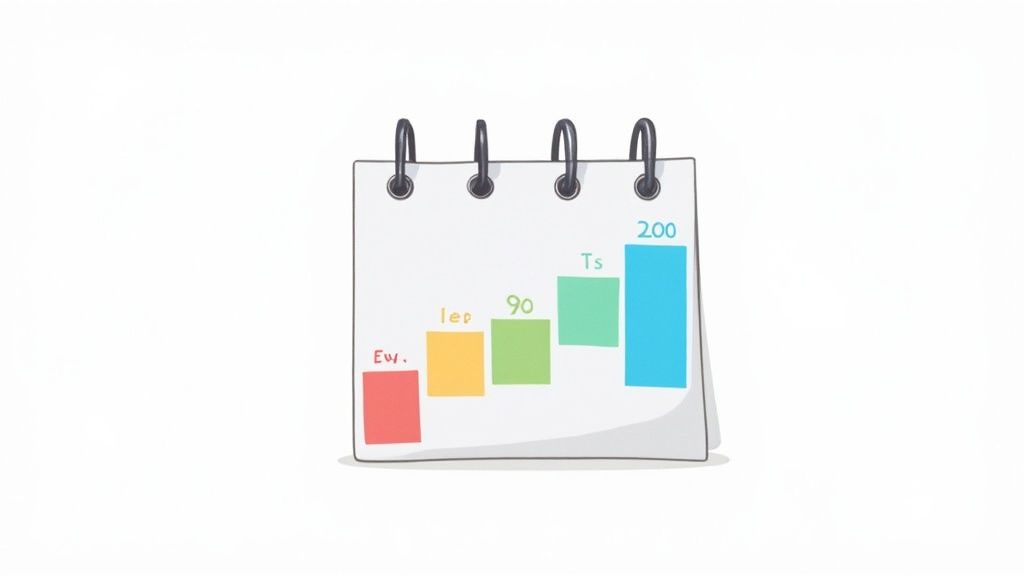How to Prioritize Tasks Effectively Without Burnout

Let's be honest: actually prioritizing your tasks feels like trying to juggle chainsaws. You spend the entire day swatting away notifications, answering "quick questions," and clearing your inbox, only to look up at 5 PM and realize you haven't touched the one thing that really mattered.
If you've ever felt busy but not productive, you're not alone. This isn't a personal failing; it's a feature of modern work. We're caught in a constant tug-of-war between what's truly important and what's just making the most noise.
The Siren Song of "Urgent"
Our brains are wired for the quick win. That little dopamine hit from archiving an email or checking off a minor to-do feels good, right? It feels like progress. Meanwhile, that big, hairy, complex project sits on the back burner because it doesn't offer that same instant gratification.
On top of that, there's the unspoken pressure to look busy. In many workplaces, frantic activity is mistaken for value. Firing off instant replies and hopping on every minor request makes you seem responsive, even if it means your most critical work is gathering dust.
The real game of prioritization isn't about managing your schedule—it's about fiercely protecting your focus. It’s about consciously deciding where your energy goes, instead of letting your inbox dictate your day.
When you're constantly reacting, you never get the chance to step back and see the bigger picture. You're just spinning on a hamster wheel, working hard but not smart. This is exactly why "just work more" is almost never the solution. You need a system to cut through the chaos.
The Tangible Cost of a Messy To-Do List
This isn't just about a feeling of being overwhelmed; poor prioritization has real, measurable consequences. Teams that get this right are 1.4 times more likely to outperform their peers. It's a massive lever for success.
In fact, a whopping 64% of project managers say that effective task prioritization is non-negotiable for delivering a project successfully. Digging deeper, organizations that build their project management around clear priorities see 38% more projects hit their original goals. You can explore more of these task management findings and see how they directly connect to results.
This is where a dedicated tool like Obsibrain makes all the difference. For example, a project manager can create a central project hub in Obsibrain, linking all tasks, deadlines, and resources. This provides a single source of truth, allowing them to apply prioritization frameworks consistently across the team, ensuring everyone is aligned on what truly drives the project forward. It gives you a clean, structured space to dump, sort, and prioritize everything on your plate—far away from the chaos of email and chat notifications. It's designed to help you build a system based on actual importance, letting you apply proven frameworks so your daily actions finally line up with your long-term goals.
Before we dive into the specific frameworks, it’s crucial to understand the fundamental concepts that underpin all of them. Getting a firm grip on the difference between "urgent" and "important" is the first real step toward taking back control of your workload.
Quick Guide to Prioritization Concepts
Here’s a simple breakdown of the core ideas that separate the urgent distractions from the truly important work.
Urgent Tasks
These are the things screaming for your attention right now. They often have clear, immediate deadlines and consequences if ignored. They're reactive.
Answering a ringing phone, responding to a "server down" alert, or fixing a last-minute typo in a presentation.
Important Tasks
These tasks directly contribute to your long-term goals and values. They often require planning and proactive effort. They're strategic.
Developing a new skill, planning a major project, networking for future opportunities, or spending time on your health.
The "Urgency Trap"
This is the cognitive bias where we instinctively prioritize urgent tasks over important ones because they feel more pressing, even if they're trivial.
Spending your morning on low-value emails instead of starting the proposal that's due in two weeks.
Understanding these distinctions is everything. Most of our stress comes from living in the "Urgency Trap," a place where we’re constantly putting out fires instead of building something that lasts. The goal of the following methods is to help you consciously shift your energy toward what’s truly important.
Decoding the Psychology of Your To-Do List

Have you ever stared down a massive to-do list, sidestepped the most critical project, and instead plowed through a dozen tiny, easy wins? You're not lazy. You're not unfocused. You're just human. Our brains are hardwired with a few cognitive biases that quietly sabotage even our best-laid plans.
One of the biggest culprits is the urgency effect. It’s that magnetic pull toward tasks with a ticking clock, even if they have zero long-term value. Answering a flood of emails feels incredibly productive because it’s immediate and time-sensitive, but it often derails the deep, strategic work that actually moves the needle.
This creates a constant tug-of-war between our rational, goal-setting mind and our reactive, instinct-driven brain. It's a battle of what we know we should do versus what we feel like doing.
Why We Choose the Easy Wins
Another mental shortcut we fall for is our love of "completion bias." Every time you check an item off your list, your brain gets a little hit of dopamine—the chemical messenger tied to pleasure and reward. It feels good, so your brain learns to chase that feeling.
This is why polishing off a bunch of small, administrative tasks often feels way more appealing than digging into a large, complex project. You can spend an entire morning feeling busy and accomplished, but in reality, you’ve just been procrastinating on the high-impact work that delivers real progress. All for a quick, cheap thrill of achievement.
By understanding these mental traps, you can begin to counteract them. The goal isn't to fight your brain's natural tendencies but to build systems that work with them to prioritize tasks effectively.
And if you think you're alone in this, you're not. A comprehensive survey found that a staggering 98.2% of workers struggle with prioritizing their tasks. It gets worse: 75.4% have serious trouble balancing their urgent work with the time they actually have, mostly thanks to constant interruptions. This mismatch doesn't just kill efficiency; it adds a ton of stress. You can read the full report on work priorities to see just how deep this problem runs.
This is where a dedicated tool like Obsibrain can make a real difference. For instance, a researcher struggling with a large, complex project can break it down into smaller sub-tasks within Obsibrain. Checking off these smaller items still provides that satisfying dopamine hit, but it's now channeled towards the important project, effectively hacking the "completion bias" to drive meaningful progress. By giving you a structured space to apply proven prioritization frameworks, it forces you to consciously evaluate a task’s importance, not just its urgency. It’s about building the discipline to override those ingrained habits and make smarter, more intentional choices every single day.
Once you get a handle on the psychological traps that pull your focus off course, you can start building a system to defend your time. Instead of just gritting your teeth and relying on willpower, structured frameworks are the way to go. Think of them less as rigid rules and more as mental models that cut through the chaos, helping you decide what to do, what to delegate, and what to drop entirely.
The goal here is to shift from reactive guessing to intentional decision-making. These battle-tested methods give you the scaffolding you need to make that happen.
The Eisenhower Matrix: Deciding What Matters
Popularized by Dwight D. Eisenhower, this framework is brilliant in its simplicity. It forces you to look at every task through two lenses: urgency and importance. This simple sorting exercise is your best defense against the "urgency trap," where time-sensitive but low-value tasks hijack your day.
You end up sorting everything into one of four quadrants:
Urgent & Important (Do): These are your non-negotiable, top priorities. They have tight deadlines and real consequences if they slip. Think of a major project deadline or a client crisis.
Important & Not Urgent (Decide/Schedule): This is where the magic happens. This quadrant is for all the strategic work that moves you toward your long-term goals but doesn't have an immediate fire attached. Examples include planning for the next quarter, learning a new skill, or nurturing professional relationships.
Urgent & Not Important (Delegate): These tasks scream for immediate attention but don’t actually need your specific expertise. They're perfect candidates for delegation. This could be anything from scheduling meetings to responding to routine emails.
Not Urgent & Not Important (Delete): These are the time-wasters, plain and simple. They don't help you reach your goals and have no real deadline. We're talking about aimless social media scrolling or organizing digital files you’ll never look at again.
The real power of the Eisenhower Matrix lies in Quadrant 2 (Important & Not Urgent). Proactively scheduling and protecting time for these tasks is the single biggest step toward moving from a reactive to a strategic workflow.
Inside Obsibrain, you can set up a quick note template with these four quadrants as headings. As tasks pop up, just tag them with something like #P1/Do, #P2/Decide, #P3/Delegate, or #P4/Delete. This gives you a repeatable system for sorting your to-do list with ruthless efficiency. For example, a marketing manager can use this template for their weekly planning note, ensuring that strategic tasks like "Plan Q3 content calendar" (#P2/Decide) get scheduled before they become urgent.
The ABC Method: Simple and Action-Oriented
If the full matrix feels a bit much for your daily grind, the ABC Method offers a more streamlined alternative. It's a fantastic way to bring order to your daily to-do list after you've already done your bigger-picture weekly planning.
Here’s the breakdown:
'A' Tasks: These are your most critical items for the day. Not finishing them has significant, immediate consequences. A freelancer, for instance, would absolutely label "Send final invoice to Client X" as an 'A' task—it's directly tied to cash flow.
'B' Tasks: These are still important, but the consequences of pushing them to tomorrow are mild. These are your "should-dos." A good example is "Research potential new clients." It's valuable, but a one-day delay won't cause a disaster.
'C' Tasks: These are the "nice-to-dos." They have virtually no negative impact if they don't get done today. Think "Organize desktop files" or "Read industry newsletter."
The golden rule is beautifully simple: you never work on a 'B' task until all your 'A' tasks are complete, and you never touch a 'C' task until all your 'B's are done. This enforces a discipline of tackling the things that truly move the needle first. For a more detailed approach, you can explore Obsibrain's built-in features for advanced task management, which pair perfectly with this method. A student, for instance, could use Obsibrain to create their daily task list, flagging "Finish math homework due tomorrow" as an 'A' task and "Start reading for next week's English class" as a 'B' task, ensuring they focus on the most immediate deadline first.
The Pareto Principle: Finding Your 20%
The Pareto Principle, often called the 80/20 Rule, is less of a daily sorting tool and more of a high-level strategic filter. It observes that for many things in life, roughly 80% of the results come from just 20% of the effort.
In the context of productivity, this means about 20% of what you do is likely generating 80% of your most valuable outcomes. The real challenge, of course, is correctly identifying that critical 20%.
For a product manager, that 20% might be conducting user research and planning the product roadmap—activities with a massive impact on success. The other 80%, like attending status meetings or answering routine emails, is necessary but far less impactful. By identifying and fiercely protecting time for that high-leverage 20%, you dramatically increase your output. A product manager using Obsibrain could create a dedicated note for "High-Impact Activities" and link all relevant research, meeting notes, and roadmap documents to it. This creates a focused workspace for their 20% work, shielding it from the distraction of less critical tasks.
This infographic shows a simplified flow for turning a raw list of tasks into a scheduled plan.  This visualization strips prioritization down to its core actions: listing everything, categorizing based on what truly matters, and then committing time on your calendar to get it done.
This visualization strips prioritization down to its core actions: listing everything, categorizing based on what truly matters, and then committing time on your calendar to get it done.
Building Your Master Task Dashboard in Obsibrain

Knowing a few prioritization frameworks is a great start, but the real magic happens when you turn those ideas into a living, breathing system. A static to-do list is dead on arrival; it's outdated the moment you write it. What you really want is a dynamic dashboard—a single source of truth that pulls everything together and gives you a clear, actionable view of your day. This is how you stop thinking about prioritizing and start doing it.
This is exactly what Obsibrain was designed for. It helps you build that integrated workflow, turning abstract priorities into a tangible, interactive system. Instead of just a flat list of tasks, you get a central command center. It doesn't just tell you what to do; it connects you to the why and the how. That connection is what separates a simple checklist from a true productivity engine.
Using Nested Tags for Granular Control
When you're drowning in tasks, the first step is to bring some order to the chaos. In Obsibrain, you can use nested tags to give your tasks multiple layers of context. This is way more powerful than a single priority flag because it lets you filter by both project and importance.
Let's say you're juggling three big projects: Apollo, Gemini, and Mercury. You can set up your tags like this:
#Apollo/P1for the most critical tasks in Project Apollo.#Gemini/P2for the medium-priority tasks in the Gemini project.#Mercury/P3for the nice-to-have items under Project Mercury.
This simple syntax instantly makes your entire task list sortable and searchable. With just a glance, you can see not just what’s important, but where that importance lies. For a use case, consider a freelance developer working for multiple clients. They can use #ClientA/Urgent and #ClientB/Bugfix to instantly filter their task list and focus on the most pressing issues for a specific client, preventing critical tasks from getting lost in the noise. It's a game-changer for anyone juggling multiple workstreams.
A well-organized dashboard isn’t just about neatness; it’s about reducing cognitive load. When your system automatically surfaces what’s most critical, you spend less mental energy deciding what to do next and more energy actually doing it.
Creating Dynamic Queries to Surface Priorities
Here's where your Obsibrain dashboard really comes alive. You can use queries to create dynamic views that automatically pull in the right information. The list updates in real-time as you check things off or as new deadlines pop up, so you're always looking at the most current set of priorities.
For example, a content creator could set up a query on their daily note that automatically pulls in all tasks tagged #Content/Writing that are due in the next three days. Boom—they've just created a "Upcoming Writing Deadlines" section on their dashboard. No more manually hunting through long lists; the system does the heavy lifting for you.
Linking Tasks to Context for Seamless Workflows
Context switching is the ultimate productivity killer. Every time you have to stop and hunt for a related document or find the meeting notes where a task was assigned, you lose momentum. This is another area where Obsibrain shines: you can link tasks directly to their context.
Imagine you have a task in your Eisenhower Matrix that says, “Delegate report analysis to Sarah.” Instead of letting that float alone, you can link it directly to the meeting notes where you decided on this and to your weekly sync note with Sarah. This creates a rock-solid accountability loop. When you click on the task, all the context you need is right there. A great use case for this is a sales executive who links a task like "Follow up with Prospect Z" directly to the note containing their call history and the prospect's specific needs. This ensures they have all the context instantly, making for a much more effective follow-up.
Finding a Prioritization System That Actually Works for You

The frameworks we've covered are fantastic starting points, but let's be honest—they aren't one-size-fits-all. The best system for prioritizing your tasks is the one you’ll actually use day in and day out. This means tweaking and personalizing these methods to fit your specific role, your work habits, and even your personality.
It all starts with a little self-awareness. Are you a morning person who should fiercely protect that time for deep, creative work? Do you constantly underestimate how long simple tasks will take? Knowing your own productivity quirks is the key to building a system that works with you, not against you.
Think about a freelance designer. They might realize their creative spark is brightest before lunch. For them, a personalized system means dedicating mornings to their 'A' tasks—like brainstorming new concepts—and pushing the administrative 'C' tasks, like sending invoices, to that classic post-lunch slump.
Combining Methods for Maximum Impact
You don't have to pledge eternal loyalty to a single framework. In fact, some of the most effective systems are hybrids, borrowing the best bits from different methods. Think of it as building your own custom productivity toolkit.
Here's a hybrid approach that I've seen work wonders for people:
Weekly Planning: Kick off your week by using the Eisenhower Matrix. Sort all your upcoming tasks into the four quadrants. This gives you a high-level, strategic view of everything on your plate.
Daily Focus: Each morning, pull tasks from your "Urgent & Important" and "Important & Not Urgent" quadrants. Then, apply the ABC Method to create a focused, actionable to-do list for that specific day.
This combination gives you both the big-picture strategy and the daily tactical clarity you need to stay on track. Your personal preferences play a huge role here. Research actually shows that once we decide on a task order, we tend to stick with it, which just goes to show the complex mental gymnastics we do when prioritizing.
Building Your Evolving System in Obsibrain
Your prioritization system shouldn't be carved in stone. It needs to be a living, breathing thing that evolves as your goals and projects change. Obsibrain is the perfect place to build and refine this kind of dynamic system.
You could, for example, use Obsibrain's daily planning features to create a template that prompts you to review your weekly Eisenhower Matrix. From there, you can select your A, B, and C tasks for the day. A team lead could use this to not only plan their own day but also to draft and share priority lists with their team, ensuring everyone starts the day aligned. You can get the full scoop on setting this up in our guide to Obsibrain's daily planning features.
A key takeaway: Schedule a quick check-in with your system. Seriously, put a recurring 15-minute appointment on your calendar every Friday. Ask yourself: What worked this week? What was a struggle? This simple habit stops you from sliding back into old, reactive habits and makes sure your system stays a powerful ally.
Even with the best frameworks in hand, the real world has a funny way of throwing curveballs.Even with the best frameworks in hand, the real world has a funny way of throwing curveballs. Let's tackle some of the common questions that pop up when you start turning these prioritization theories into your daily routine.
How Do I Handle Urgent Tasks That Disrupt My Planned Priorities?
It happens to everyone. You have a perfectly planned day, and then an "urgent" request lands in your lap, threatening to derail everything. The trick is to pause before you react.
Don't just jump on the new task. Instead, run it through a quick mental Eisenhower Matrix: is this thing genuinely urgent and important?
If it is, then yes, it might be time to bump something else down the list. But if it's urgent for someone else but not actually important to your goals (a classic "quadrant 3" task), see if you can delegate it or, better yet, schedule it for a later, more appropriate time.
A powerful technique I use in Obsibrain is a dedicated "Inbox" note. Whenever an unexpected request comes in, I immediately dump it there. This simple act of logging it gets it out of my head and gives me the breathing room to assess it thoughtfully instead of letting interruptions dictate my day. A perfect use case for a support manager who gets ad-hoc requests via chat all day. They can quickly add tasks to their Obsibrain inbox and then process them in a batch once an hour, preserving their focus on deeper work.
That small buffer between the request and your action is where you reclaim your focus.
How Often Should I Review and Adjust My Priorities?
Finding the right rhythm for reviewing your priorities is key to staying on track without getting bogged down in constant planning. I've found a two-tiered approach works wonders.
Daily Triage (5 minutes): At the start of each day, do a quick scan and identify your top 1-3 priorities. Think of these as your "A" tasks from the ABC Method. This is your non-negotiable list for the day.
Weekly Review (30 minutes): Set aside a block of time, maybe Friday afternoon, to look at the bigger picture. This is when you use the Pareto Principle to gut-check your efforts. Did you spend your time on the high-impact 20%? What needs to shift for the week ahead?
This cadence keeps you agile enough to handle daily shifts while making sure all those small actions are still adding up to your long-term goals.
Can I Use These Frameworks for Both Personal and Professional Tasks?
Not only can you, but you absolutely should. The most effective productivity systems are the unified ones that give you a single, holistic view of all your commitments.
Trying to juggle separate to-do lists for work and life is a fast track to burnout. It operates on the false assumption that your time and energy are infinite, separate pools. They're not.
A better way? Use simple tags like #work and #personal inside Obsibrain to filter everything within one central dashboard. Apply the exact same prioritization logic to both. An "urgent and important" personal task—like booking a crucial doctor's appointment—absolutely deserves to be weighed against your work deadlines. For more on integrating different parts of your life, check out the Obsibrain FAQ page for some extra tips.
This integrated approach helps you make realistic decisions about your time and fosters a much healthier work-life balance.
Ready to stop juggling and start prioritizing with a system that actually works? Obsibrain provides the templates and structure you need to build a powerful, centralized task management dashboard. Transform theory into action and regain control of your day by visiting https://www.obsibrain.com/en.
Last updated
Was this helpful?